Do you have a question about the Baxi Luna 310 Fi and is the answer not in the manual?
Lists common external issues encountered during boiler start-up, such as venting and air in the system.
Details essential checks required when commissioning the boiler, including gas pressure and power supply.
Advises against changing components like PCBs or pumps without proper diagnosis.
Emphasizes collecting customer and system details prior to troubleshooting.
Highlights the importance of asking basic questions to diagnose issues effectively.
Addresses the issue where the boiler fails to start with no LED indicators illuminated.
Covers scenarios where the boiler does not start, but the #12 LED is illuminated.
Troubleshoots the boiler not starting when #13 LED is off, but #12 LED is on.
Addresses the boiler failing to start with #12 and #13 or #14 LEDs illuminated.
Provides solutions for when the boiler's pump is not functioning.
Explains how to resolve issues related to air trapped within the heating system.
Offers troubleshooting steps for a malfunctioning flow switch.
Guides on resolving the situation where the pump runs but the fan does not.
Details troubleshooting for an inoperative air switch.
Troubleshoots the fan running with the #8 (50°) fault code flashing.
Addresses the boiler failing to ignite indicated by the #6 (30°) fault code.
Diagnoses issues when the boiler ignites but then shuts down with a #6 fault code.
Provides solutions for the boiler failing to modulate its burner output.
Troubleshoots flame failure faults, including gas supply and flame sensor issues.
Addresses fault codes related to the safety thermostat being activated.
Covers troubleshooting for faults indicated by the #8 (50°) code, relating to fan or flue.
Diagnoses faults indicated by #9 (60°) code, concerning pump or low system pressure.
Troubleshoots faults indicated by the #10 (70°) code, related to the DHW sensor.
Addresses faults indicated by the #11 (80°) code, concerning the primary sensor.
Explains causes and solutions for the boiler experiencing short cycling.
Provides guidance on resolving whistling noises, particularly with glycol in the system.
Covers troubleshooting for fluctuating domestic hot water temperatures at the tap.
Details how to address erratic burner pressure readings during operation.
Addresses issues where the hot water output is insufficient.
Troubleshoots problems where cold water mixes with hot water at the taps.
Addresses concerns about perceived low water pressure at bath taps.
Covers scenarios of receiving little or no hot water from taps.
Explains why the boiler might be slow to start in domestic hot water mode.
Diagnoses why the boiler might shut down due to safety thermostat activation.
Troubleshoots the #6 (30°) fault code, indicating flame failure.
Addresses the #7 (40°) fault code related to the safety thermostat.
Covers the #8 (50°) fault code, indicating fan or flue issues.
Troubleshoots the #9 (60°) fault code for pump or low system pressure.
Addresses the #10 (70°) fault code related to the DHW sensor.
Covers the #11 (80°) fault code for the primary sensor.
Lists common external issues encountered during boiler start-up, such as venting and air in the system.
Details essential checks required when commissioning the boiler, including gas pressure and power supply.
Advises against changing components like PCBs or pumps without proper diagnosis.
Emphasizes collecting customer and system details prior to troubleshooting.
Highlights the importance of asking basic questions to diagnose issues effectively.
Addresses the issue where the boiler fails to start with no LED indicators illuminated.
Covers scenarios where the boiler does not start, but the #12 LED is illuminated.
Troubleshoots the boiler not starting when #13 LED is off, but #12 LED is on.
Addresses the boiler failing to start with #12 and #13 or #14 LEDs illuminated.
Provides solutions for when the boiler's pump is not functioning.
Explains how to resolve issues related to air trapped within the heating system.
Offers troubleshooting steps for a malfunctioning flow switch.
Guides on resolving the situation where the pump runs but the fan does not.
Details troubleshooting for an inoperative air switch.
Troubleshoots the fan running with the #8 (50°) fault code flashing.
Addresses the boiler failing to ignite indicated by the #6 (30°) fault code.
Diagnoses issues when the boiler ignites but then shuts down with a #6 fault code.
Provides solutions for the boiler failing to modulate its burner output.
Troubleshoots flame failure faults, including gas supply and flame sensor issues.
Addresses fault codes related to the safety thermostat being activated.
Covers troubleshooting for faults indicated by the #8 (50°) code, relating to fan or flue.
Diagnoses faults indicated by #9 (60°) code, concerning pump or low system pressure.
Troubleshoots faults indicated by the #10 (70°) code, related to the DHW sensor.
Addresses faults indicated by the #11 (80°) code, concerning the primary sensor.
Explains causes and solutions for the boiler experiencing short cycling.
Provides guidance on resolving whistling noises, particularly with glycol in the system.
Covers troubleshooting for fluctuating domestic hot water temperatures at the tap.
Details how to address erratic burner pressure readings during operation.
Addresses issues where the hot water output is insufficient.
Troubleshoots problems where cold water mixes with hot water at the taps.
Addresses concerns about perceived low water pressure at bath taps.
Covers scenarios of receiving little or no hot water from taps.
Explains why the boiler might be slow to start in domestic hot water mode.
Diagnoses why the boiler might shut down due to safety thermostat activation.
Troubleshoots the #6 (30°) fault code, indicating flame failure.
Addresses the #7 (40°) fault code related to the safety thermostat.
Covers the #8 (50°) fault code, indicating fan or flue issues.
Troubleshoots the #9 (60°) fault code for pump or low system pressure.
Addresses the #10 (70°) fault code related to the DHW sensor.
Covers the #11 (80°) fault code for the primary sensor.
| Fuel Type | Natural Gas |
|---|---|
| Mounting | Wall-mounted |
| Maximum working pressure | 3 bar |
| Water content | 1.7 liters |
| Flue diameter | 60/100 mm |
| Type | Combination Boiler |
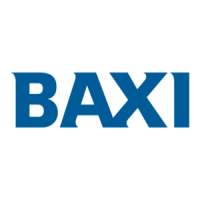



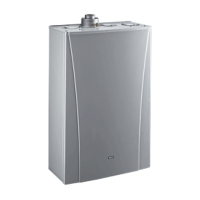
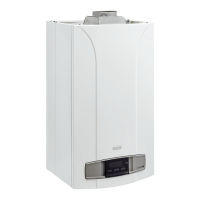



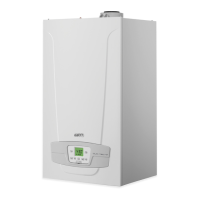
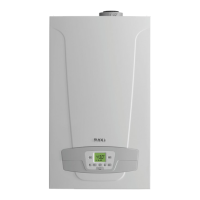
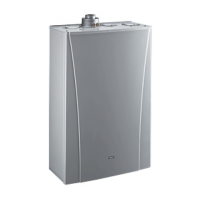
